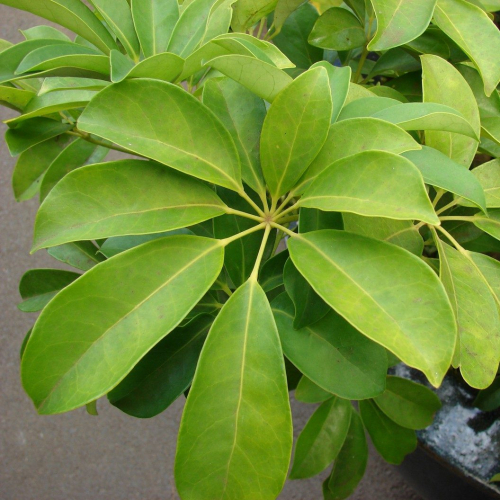Indoor plants Schefflera

Description
Characteristic Features of Schefflera
Schefflera is a genus of evergreen plants in the family Araliaceae. The plants are mainly shrubs as well as lianas and trees of different heights. Currently, the website of GRIN (Germplasm Resources Information Network) sponsored by the US Department of Agriculture lists 28 species. Almost all species in the family have one or more Latin synonyms so at a plant exhibition and/or sale you can see Schefflera under completely different names: Agalma, Brassaia, Vitis, Heptapleurum, Didymopanax, Dizygotheca, Panax, Paratropia, Sciadophyllum, Tupidanthus etc. Probably for this reason, the less authoritative sources claim that the number of species in the genus amounts to 150 to 200.
Schefflera is widely distributed across various tropical areas. The plants are prized for their attractive palmately compound leaves. The flowers are less decorative, small, gathered in umbels, heads, or panicles. Below is a list of species most commonly grown indoors:
- Schefflera octophylla (Octopus Tree) is native to Taiwan. Its common name reflects the similarity of the eight elliptical leaflets to the octopus's tentacles. However, young plants might only have 5 leaflets and older plants as many as 16. A leaflet is 30-40 × 5-10 centimeters, with a pointed tip and petioles 1-2 centimeters long. The main petiole is much longer and tends to droop. The tree does not grow tall. Schefflera octophylla is often confused with Schefflera actinophylla.
- Schefflera actinophylla is native to tropical Australia and can reach 12 meters in height. The plant has a sturdy straight trunk with greyish brown thickening at the base. Each leathery glossy leaf has 15-16 leaflets 20-30 centimeters long. The leaflets are broad in the middle and overlap each other.
- Schefflera digitata is native to New Zealand. This tree does not grow tall (3-8 meters). The leaves are thin, with a parchment-like feel. There are 7 to 10 leaflets sized 6-8 × 4-6 centimeters.
- Schefflera arboricola native to Australia and New Guinea is a very popular potted plant. Based on the name, you could think it is also a tree and will be wrong. Actually, this is liana. It does not branch out but produces basal shoots. For a bushy effect, plant two or three specimens in one pot. Shape it on supports.
Each leaf of Schefflera arboricola has 7 to 16 oval or elliptical leaflets the size of a human palm. Breeders created variegated forms with white, yellow, or cream coloured spots and / or streaks ('Beauty', 'Golden Chapel', 'Green Chapel', 'Diana', and 'Compact').
With a good care, Schefflera can blossom but it will not happen until the plant is 8 years old. Lower leaves eventually fall off. The flowers are very small (0.5 centimeters in diameter) and are not likely to compensate for the bare trunk so make sure to plant young Scheffleras in the same pot.
The Secrets to Successfully Growing Schefflera
Schefflera does well in bright filtered light. Good light is particularly important for variegated forms as their foliage becomes soild green in low light. Schefflera withstands 3-4 hours of direct sunlight per day. In the summer, you can place it on the balcony or in the garden. Outdoor air is good for the plant but remember to choose a place in the light dippled shade. In the winter, provide supplemental lighting. For non-variegated forms, light of daylight fluorescent lamps will be sufficient.
Water with soft settled water. In the spring and summer, water moderately and regularly. Do not allow the soil dry out. In the winter, water sparingly as overwatering together with low temperatures can cause leaf spot.
Very high air humidity is essential so mist the plant with warm soft water at least 5-6 times per day.
The best temperatures are 18-22 ° C in the summer and 13-16 ° C (not lower than 12 ° C) in the winter. Avoid sudden changes in temperature and drafts.
During the active growth period from spring to autumn, fertilize Schefflera twice per month with indoor plant fertilizer or compound mineral fertilizer for foliage plants.
Repot young plants each year in the spring or autumn. After the plant is three years old, repot once in 2 or 3 years. Use fresh, slightly acidic (pH = 5.0-6.0) or neutral (pH = 6.0-7.0) soil. Prepare it from loam, leaf mold, and sand at 2:3:1 or buy foliage houseplant potting mixture. If you grow Schefflera in a tub or large pot outdoor and the plant is two meters tall or more, repotting might be complicated. Topdress the plant with about 10-15 centimeters of fresh soil every spring.
Schefflera can be propagated by semi-lignified tip or medial cuttings in any season, preferably in the spring. You will need: 1) a propagating case; and 2) root stimulant. Schefflera can be propagated by seed with the soil temperature not lower than 20-25 ° C.
Cut off the top (5-7 leaves) when and if you want to stimulate the formation of side shoots. However, sometimes only a single shoot appears.
Potential Problems
Leaves can wither in low light and get discoloured patches when there is too much sun.
Insufficient light together with low humidity causes the new leaves die off and older leaves drop.
Waterlogging results in root rot.
The tips of the leaves turn dry and brown probably due to underwatering and / or low humidity.
The leaves may drop in the summer because of too high temperatures and in the resting period (October to February) because of too low temperatures and waterlogging.
Insufficient nutrient content in the soil slows down growth and leaf development.
Schefflera is often affected by mealybugs, spider mites, and scale insects. Spider mites and scale insects are especially dangerous if the air is too dry.







 83 816
83 816







